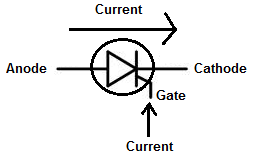What is a Silicon-Controlled Rectifier?
A Silicon-Controlled Rectifier is a three-lead semiconductor device that acts as an electrically controlled switch.
When a specific positive trigger voltage/current is applied to the SCR's gate lead (G), a conductive channel forms between
the anode (A) and the cathode (C) leads. Current flows in only one direction through the SCR, from anode to cathode, like a diode.

The unique characteristic of silicon-controlled rectifiers has to do with its conduction state after the gate current is removed. After an SCR is triggered into conduction (by allowing sufficient current to the gate lead), removing the gate current has no effect. The conduction from anode to cathode continues. That is, the SCR will remain on even when the gate current/voltage is removed. The only way, then, to turn the device off is to remove the anode-to-cathode current or to reverse the anode and cathodes polarities.
In terms of applications, SCRs are used in switching circuits, phase-control circuits, inverting circuits, clipper circuits,
and relay-control circuits. One of the most important circuit applications is in alarm circuits. Think of how when an alarm is triggered. Once
it is triggered, the alarm stays on, until an external source shuts it off. SCRs remain off until shut off, making them perfect in alarm circuit
applications.